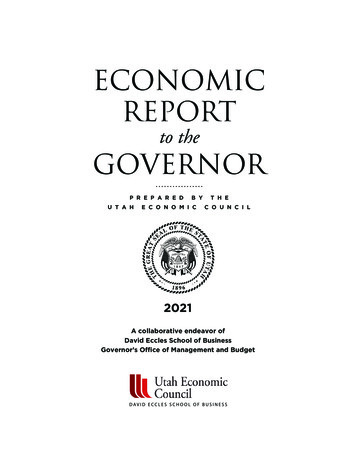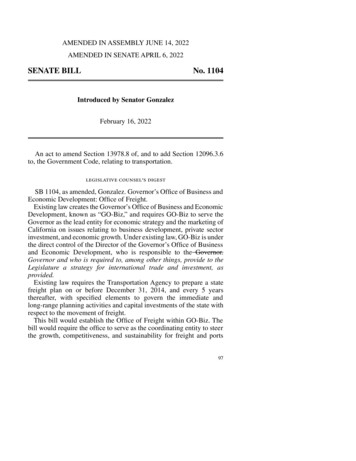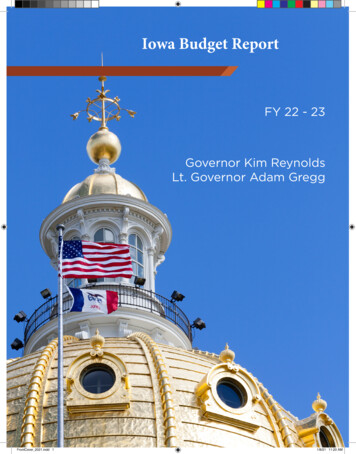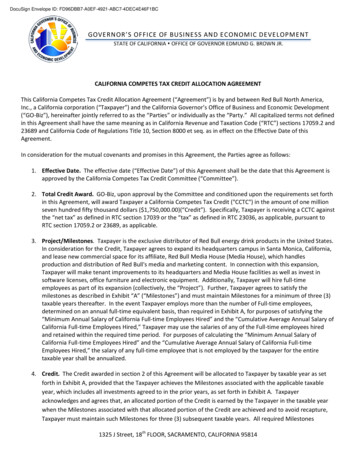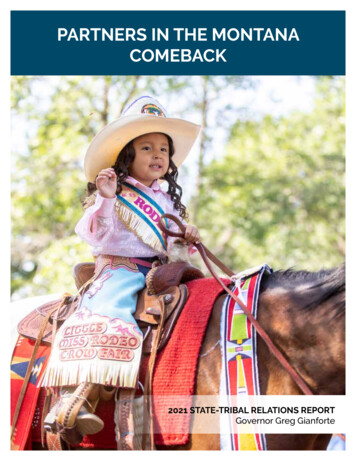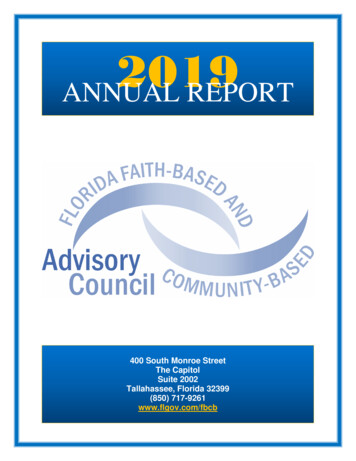
Transcription
TEXAS HISTORICAL COMMISSIONThis travel guide is made possible throughthe Texas Historical Commission’s partnershipwith the Texas Department of Transportation,Office of the Governor - Economic Development and Tourism, Texas Parks and Wildlifeand Texas Commission on the Arts.The Texas Historical Commission, the stateagency for historic preservation, administers avariety of programs to preserve the archeological,historical and cultural resources of Texas.TEXASLakes TrailRREEGGIIOONNTexas Heritage Trails ProgramThe Texas Historical Commission is a leader inimplementing and promoting heritage tourismefforts in Texas. The Texas Heritage TrailsProgram is the agency’s top tourism initiative.For additional copies of this brochure,call 866.276.6219.Funding provided through TxDOT’s StatewideTransportation Enhancement ProgramCopyright 2003, Texas Historical CommissionPrinted in Texas, No. 10/03- 450MInset: Wise County Courthouse, DecaturBackground: Lake TexomaBackground: TxDOTEXPLORING THE HERITAGE OFNORTH CENTRAL TEXAS
TheTexas Lakes TrailWhere the Old South meets the Wild WestGeographically and historically, the Texas Lakes Trail Region of NorthTexas has long been a meeting place. Once, a great ancient sea metthe land here.The sea receded. The land became rolling tallgrass prairies —the Blackland and Grand Prairies — located between piney woods tothe east and wind-blown plains to the west. Major rivers — the Red,Trinity, Brazos, Sabine and Sulphur crossed the prairies, as did beltsof hardwood forests called the Eastern and Western Cross Timbers.In these verdant grasslands and scattered forests, game such asbuffalo, pronghorn and bear thrived. Bands of Wichita and CaddoIndians lived here in domed grass huts, hunting game and growingcorn, tobacco and melons.Spanish soldiers of the De Soto-Moscoso Expedition trekkedhere in 1542, searching in vain for gold and silver. The Frencharrived from neighboring Louisiana in the 1700s, engaging in tradewith local Indians.During the first half of the 19th century, settlers from the Southand Midwest trickled into the region. The trickle became a floodafter the Republic of Texas became the state of Texas in 1845. Cottongrowers and their slaves extended the cotton culture to the prairies,turning rich Blackland into cotton plantations.Background: TxDOTDowntown Grapevine
As farms and towns cropped up, authoritiespushed out native peoples and establishedfrontier forts, including Fort Worth, toprotect the settlers.Frontier settlers kept up with newsfrom “back East” via the ButterfieldOverland Mail stagecoaches which rambled through here(1858–61) on their way from St. Louis to California.Despite anti-secession sentiment in a few counties, theregion supplied men and materials to the Confederacy during theCivil War. After the war, families fled the ravaged South for a freshstart on the prairies and freed slaves moved from plantations intogrowing towns such as Dallas.A new Texas enterprise arrived on the prairies in the 1870sand 1880s — the cowboyculture. Drovers herdedmillions of Longhorns fromSouth Texas through NorthTexas along the Chisholm,Shawnee and Western cattletrails, crossing at the RedRiver on their way to marketrailheads in Kansas.Cattle and cotton shapedthe culture, but steel railsbrought the first prosperity inthe late 1800s. With the arrivalof trains, Texas cattle, cottonand other agricultural products found unprecedentedaccess to outside markets.Fossil Rim Wildlife Center,Glen RoseHopkins County Museum andHeritage Park, Sulphur SpringsBackground: TxDOT2By the turn-of-the-20th century, rising wealth and burgeoning populations turned Dallas and Fort Worth into centers ofcommerce and culture. In the 1910s and 1920s, oil discoveriesin North Texas further boosted the economy.Big lakes began dotting the prairies beginning in the 1930s,as several decades of federal dam building impounded morethan 30 major lakes, providing reliable water resources to agrowing region. The Trinity River basin formed lakes such as RayRoberts, Lewisville, Lavon, Ray Hubbard, Cedar Creek andRichland Creek. On the Sabine River came Lake Tawakoni. Thelargest of all, Lake Texoma, harnessed the middle stretch of theflood-prone Red River. Reservoirs also created new opportunitiesfor outdoor recreation.Today, the Lakes Trail Region sprawls across 31 countiesfrom the Red River in the north to the Bosque River in thesouth, from the prairie cities of Paris and Sulphur Springs in theExperience a culture shaped bycattle and cotton.
east to the plains cities of Wichita Falls and Vernon in the west.The Dallas-Fort Worth metroplex remains the regional hub,offering an array of world-class cultural, commercial andeducational opportunities.Cities, towns and farms have replaced the tallgrass prairies,though a few still exist. The Texas Lakes Trail Region remains ameeting place — where the heritage of the Old South meets theheritage of the Wild West.The Texas Historical Commission created this brochure tohighlight heritage sites that preserve the fascinating story of thediverse peoples — Indians, Spanish, French, Americans, Africanslaves and Texans — who made this place their home.TxDOTHistoric home, FarmersvilleBosque County Museum, CliftonParker County Peach Festival, Weatherford3
Overflowing with adventure, beauty and history, the TexasLakes Trail Region offers an exceptional travel experience.283With so much to see and do, the only problem is deciding70287where to start. This travel guide makes that easy by divid-183Vernoning the region into four sections, each accessible from the Dallas-Fort Worth area.Each is filled with the heritage and culture that makes the region, as well as Texas,truly unique. Here are a few of the many things to see and do:704Electra287Santa RosaLake25183283hit a Rive rW icLake KempExplore history museums on topics from the cotton and cattle cultures toAfrican American and Hispanic heritage.Peruse shops and eateries on quaint courthouse squares or tour world-classart museums.Watch cowboys vie in rodeos and Native Americans dance in powwows.Enjoy shows at restored vaudeville theaters or overnight in historic lodgings.Ride a steam-powered train or hop a 1940s urban electric trolley.Sample Texas wines or nibble on fruitcake famous for more than a century.Visit the world’s largest state fair or the world’s largest flea market.Step inside the ancient footprint of a dinosaur or stroll prairies unchangedin 150 9Miller's CreekReservoir380Throckmorton183PKHubbard CreekTEXAS LAKESTRAIL REGIONReservoir283Miles 06Km351020103018010203035INTERSTATE HIGHWAY3776U.S. HIGHWAY171STATE HIGHWAY40183NTEXAS TRAVEL TRAILTRAVEL INFORMATION CENTERPioneer Park, Dallas4
17770OKLAHOMA3777944Lake Texoma82287LeWi t tlicRh i taiR ed Riv rLakeNocomav er75Henrietta287LakeArrowheadMontagueC le81287ontDeiRiv erMineralWells180Eagle ord820Mesquite20Lake PatBra Cleburnezos67171Nararro estineLakeFairfield357984er8484sRiveyRivRi ve193114u6Tyler27430922qBosClifton171Cantonhe ctorLakeCedar CreekReservoirBardwell Lake22144220t he Tri n2873417467377L eon R nnisEdgewood34of377erKaufmanF orkRiverElmCleburne144281Waxahachiee Riv807767EmoryS a b inTerrellT20287LakeGranbury2058063545GranburyLake ForkLakeTawakoniLake Ray Hubbard30Cedar Hill FerrisBenbrookLake37734276ityJoe Pool LakeBrazos Rive r30White RockLakeArlingtonFort Worth2020180SulphurSpringsRockwall78Farmers Branch6719Pres. GeorgeBush TurnpikeBedfordIrving Dallas 12360183LavonLake5121rinLake Palo PintoLewisvilleLakeGrapevine th S u l6938035E28119912182N orth Sulphu r nt380ty380PossumKingdomLakeRay knC59Sherman5635arCCoffee Mill LakeLakeCrockettLake MayseLake Crook91Moss Lake81rRiveRedeWichitaFallsWacoLakeMexia79195
Southwestern CorridorFor a true Texas experience, live it up in the big city thenhead out to uncover quaint small towns. Explore communities that offer everything from baseball memorabilia toauthentic dinosaur tracks.FORT WORTHNo wonder Fort Worth is “where the West begins.” It was establishedin 1849 as a military post on the Texas frontier. Cattle drives rumbledthrough from the 1860s to the 1880s and Fort Worth became “Cowtown.” After the arrival of the railroads in the 1870s, the town grew intoa railhead, stockyards and beef packing center.That Western heritage rings true across blocks of the StockyardsNational Historic District. Restored mercantile buildings and stockyardsfrom the early-20th century embody the city’s Western flair. Along brickpaved Exchange Avenue, shops sell handcrafted saddles, chaps, hatsand boots.Located in the 1904 Livestock Exchange Building, the StockyardsCollection & Museum chronicles the stockyards’ heyday through earlyphotos and memorabilia. Adapted sheep and hog pens house theStockyards Station, a marketplace of Western and Indian art galleries,restaurants, gift shops and Western clothing stores. The station alsoserves as a depot for the Grapevine Vintage Railroad (see Grapevine).Twice-daily Longhorn cattle drives and historicdistrict walking tours begin here.The Stockyards boasts the 1907 Stockyards Hotel (where Bonnie and Clyde stayedin room 305), and the White ElephantSaloon (an 1880s saloon that annuallyre-enacts the “Last Great Gunfight of the OldWest”). It’s also home to the Texas CowboyHall of Fame, a horse barn-turned-museumthat interprets the heritage of the Texascow-horse culture.Three of the Cultural District’s six majormuseums showcase the Old West. The newstate-of-the-art National Cowgirl Museumand Hall of Fame documents women of theAmerican West — including cowgirls andranch women, but also writers, artists,teachers and entertainers.Cowtown souvenirs,Fort Worth6The Cattle Raisers Museum chronicles Texas ranch life throughfilm, photos, interactive exhibits and displays of ranching memorabilia.The recently expanded Amon Carter Museum originally showed400 works from local philanthropist Amon G. Carter’s Western artcollection. It broadened its focus and now houses a wide range of19th- and 20th-century American art and photographs.Two other Cultural District museums showcase Fort Worth’s urbanside. Opened in 1972, the Kimbell Art Museum remains one of theworld’s finest museum designs (by American architect Louis I. Kahn)and houses one of the world’s finest art collections. Across the street isthe new Modern Art Museum of Fort Worth. Texas’ oldest art museum(founded in 1892) boasts Texas’ newest art museum building, openedin 2002. Celebrated Japanese architect Tadao Ando designed the newModern to be as artistic as the avant-garde works inside.History rides high in downtown’s Sundance Square, a 20-blockarea named for the outlaw Sundance Kid, who hung out here withThistle Hill, Fort Worth
Experience the pioneer era at Log Cabin Village. This living historymuseum in a city park features seven preserved pioneer homes builtduring the 1850s. Historical interpreters, dressed in period clothing,pose as pioneers in the homes and at a water-powered gristmill, oneroom schoolhouse, blacksmith shop and herb garden.A more opulent era is on view at Thistle Hill. One of the region’sfew Georgian Revival mansions, the 11,000-square-foot home was builtby cattle baron W.T. Waggoner as a “honeymoon cottage” for his onlydaughter, Electra.Fort Worth’s high-flying heritage unfolds at the American AirlinesC.R. Smith Museum. Dedicated to C.R. Smith, founder of the FortWorth-based airline, the museum retells the airline’s development andthe evolution of commercial aviation.Stockyards National Historic District, Fort Worthpartner Butch Cassidy. Its redbrick streets and restored turn-of-the-20thcentury structures host theaters, restaurants and lodging. The opulentTarrant County Courthouse presides proudly over this area.New to downtown is the Fort Worth Rail Market. Housed in a 1937Santa Fe Railway warehouse, the market boasts several eateries andshops selling coffee, wine, flowers and gifts — plus a weekend farmers’market in the spring and summer.ARLINGTONFertile Blackland drew farmers here in the 1840s. Today, Arlington isfertile ground for lively attractions, including Johnnie High’s CountryMusic Revue. Baseball fans flock to the Texas Rangers’ Ballpark inArlington for games and to relive legendary sports moments at theLegends of the Game Baseball Museum and Learning Center. The24,000-square-foot museum has exhibits on the Texas Rangers, pluslesser-known teams of the Texas League and the Negro League. Builtin 1914, the Fielder House Museum features a variety of exhibitsincluding a turn-of-the-centurybarbershop and general store.1199Eagle 8336082030Weatherford180ArlingtonFort Worth2020Joe Pool LakeBrazos Rive ke377Granbury377Grapevine81287Lake PatBra Cleburnezos6735W35E171Log Cabin Village, Fort Worth174144220281rLakeWhitneyMeridian171Legends of the GameBaseball Museum andLearning Center, o7
GRANBURYGranbury offers the quintessential Victorian town square. In fact, itsNational Register downtown serves as a model for historic preservationnationwide.Centered around the Second Empire-style Hood County Courthouse (1890), more than 50 quaint antique and specialty shops,restaurants and boutiques line the square. Visitors can take horsedrawn carriage rides and overnight at more than 20 local bed andbreakfasts, many in historic homes.Most historic among downtown’s several live entertainment venuesis the Granbury Opera House. Established in 1886 as Kerr’s Hall (anopera house until it closed in 1911), the venue was restored in the1970s and annually stages some 300 musicals, plays and melodramas.For family movies under the stars, visitors flock to the BrazosDrive-In Theater, open weekends Mar. 1 to Dec. 1. This 1950s-era, singlescreen drive-in is one of only a dozen or so still operating in Texas.History takes center stage at the Hood CountyMuseum in an 1880s jail. Cells and gallowsupstairs remain largely intact. Downstairs, sheriff’squarters contain exhibits. One tells the story ofcounty namesake and Confederate Gen. John BellHood and his Texas Brigade.GLEN ROSEWater is essential to understanding Glen Rose history. In 1860 CharlesBarnard settled on the Paluxy River and routed its flow through a stoneflour and gristmill. An art gallery is now in Barnard’s mill. Abundantmineral springs attracted self-styled healers who set up sanatoriums.During Prohibition, the waters made the area a moonshine mecca.Some hundred million years earlier, the Paluxy attracted a lostbreed — dinosaurs. Visitors see the state’s best-preserved dinosaurtracks just four miles from Glen Rose at 1,525-acre Dinosaur ValleyState Park.Three miles from town, endangered wildlife still thrive at FossilRim Wildlife Center. The 1,400-acre former wild game ranch protects32 species of endangered, threatened and native animals representingseveral continents.CLEBURNEExcellent water in West Buffalo Creek attracted pioneer travelers,including cattlemen from the nearby Chisholm Trail, to what’s now Cleburne. In the late 1800s and early 1900s, Cleburne was a transportationcrossroads, where several rail lines, an interurban train from FortWorth and a streetcar line moved people and products. This story andmore are detailed at the city’s Layland Museum, housed in a century-oldCarnegie Library. Started with collections from local businessmanWilliam J. Layland, the museum maintains 10,000-plus artifacts, anextensive research library and archives and a restored upstairs theater.Layland Museum, CleburneHood County Museum, GranburyDowntown Granbury8
CLIFTONThe original name — Cliff Town, after the surrounding limestone cliffs— eventually was shortened to Clifton. The town is located in southernBosque County, an area known as the Norwegian Capital of Texas.The first Norwegian settlers arrived in 1854, the year the county wasestablished.Clifton’s Bosque Memorial Museum preserves that heritage.Opened in 1923 with artifacts from Norwegian pioneer Jacob Olson, themuseum contains the largest collection of Norwegian artifacts in theSouth and Southwest.The nearby Bosque Conservatory shares Norwegian roots. It’shoused in the 1923 administration building of the former Clifton College, a private school formed in 1896 with support from the NorwegianLutheran Churches of America. The facility now serves as a center forthe arts, with performances and art exhibits year-round.HILLSBOROThe 1890 Hill County Courthouse is an inspiration not only because ofits 70-foot clock tower and eclectic design by notable architect W.C.Dodson. In 1993, it was ravaged by fire, but was immediately rebuiltand remains a testament to local commitment to heritage.County history fully unfolds at the Hill County Cell Block Museum.Located a block north of the courthouse in the 1893 county jail, theNational Register building chronicles county history from prehistoryto today. An unusual display features memorabilia about native sonWillie Nelson. The site also features a restored 19th-century Cumberland Presbyterian church and picturesque gazebo.Military history fills Hillsboro’s Texas Heritage Museum. Locatedin the Harold B. Simpson History Complex at Hill College, the museumrecounts combat experiences of Texans from the Civil War to WorldWar II.TxDOTLearn about a county’s rich history where itsmost dangerous outlaws once slept.Regional wildflowerTxDOTDinosaur Valley State Park,Glen Rose9
Northwestern CorridorThe western flair and unique “culture meets cowboy”atmosphere that embodies Fort Worth is also manifest innearby communities. A restored historic schoolhouse, atrue Texas wine festival and a town with Hollywood tiesare just a few of the attractions awaiting visitors.The depot houses the Grapevine Historical Museum and theGrapevine Convention and Visitors Bureau Information Center. It’s alsohome to the historic Grapevine Vintage Railroad. Named for an earlyspider-like railroad map, this restored 1896 steam excursion train runsdaily 21 miles to the Fort Worth Stockyards.Up Main Street from the depot lies the recently restored 1939Palace Theater. The one-time movie palace is now Grapevine Opry,a 500-seat venue for country music shows by headliners such asWillie Nelson, Charlie Walker and the Judds. BEDFORDWorld War I was underway when a principal, four teachers and students moved into the new Bedford School in 1915. Outgrown by 1969,the redbrick building was all but gutted by fire in 1991. Communityefforts restored the National Register schoolhouse to its originalClassical Revival style. The Old Bedford School now is a visitor’s centerand performance hall with music and theater in a large auditorium.Its authentically furnished classroom depicts education in the early20th century. GRAPEVINEOnce called Cross Timbers, by the 1850s Grapevine was officially namedafter a creek where wild Mustang grapes proliferated. Heritage and aspecial grape product — wine — now proliferate here. In fact, halfa dozen Texas wineries host tasting rooms in Grapevine’s historic MainStreet District, also the site of fine eateries, art galleries and shopping.Each September, the city hosts GrapeFest, one of America’s largestwine festivals. Grapevine is even home of the Texas Wine and GrapeGrowers Association. It’s located in the Grapevine Heritage Center andHistorical Museum, a three-acre site encompassing a blacksmith shop,leather shop, farmers market, heritage garden and the restored 1901Cotton Belt Railroad Depot.DENTONDenton has been a college town for more than a century. It’s homeof the University of North Texas (UNT), established 1890, and TexasWoman’s University (TWU), authorized 1901. Music devotees nationwide know UNT for advanced music programs, especially jazz. And fansof architecture know TWU’s Little Chapel-in-the-Woods. Designed in the1930s by Texas regionalist architect O’Neil Ford, the chapel was namedone of the state’s top 20 buildings in 1983.Watching over downtown Denton is the domed clock tower of thegrand 1897 courthouse. Inside, the Courthouse-on-the-Square Museumdepicts county history through early photos, plus exhibits on prominentearly families, including African Americans and Hispanics. The museumalso displays Indian pottery, American pressed blue glass, thimbles fromaround the world and the quirky folk art people of B. W. Crawford,made entirely from pecans.Grapevine Vintage RailroadOld Bedford School, Bedford10Bayless-Selby HouseMuseum, Denton
An associated downtown heritage site, theBayless-Selby House Museum, offers tours andlectures in an 1898 Queen Anne-style home representing life at the turn-of-the-20th century.28370287OKLAHOMAVernon 797044Electra28725183283hit a Rive rW ic82287Li tLake KemptleWi cRh i taiv eR ed Riv rreSanta RosaLakeWichitaFallsLakeNocomaHenriettaMoss ad287MontagueGainesvilleArcherCityBowieC le8128779PilotreekRay PointRoberts377LakenC5928135arCkreeMiller's tur380nTrityi380380Ri35Ev er35W281199183PossumKingdomLakeWatchingover downtownTEXAS LAKES TRAIL REGIONDenton is the domed clocktower of the grand 1897Ncourthouse.Miles 0Km6351020103018010203035INTERSTATE HIGHWAY3776U.S. HIGHWAY171STATE HIGHWAY40Eagle MountainLakeLakeWeatherfordHubbard CreekReservoir283180180Weatherford20Brazos Rive ord199LakeWorth1833608203020180Fort WorthArlingtonJoe Pool Lake377BenbrookLake67287Denton CountyCourthouse,DentonTxDOTGAINESVILLEDuring the cattle drive era, Gainesville became asupply point for cowboys moving herds north toKansas. Later, cotton and oil sustained the economy. During the 1930s, the town gained a nationalreputation for the Gainesville Community Circus,a community fund-raising project. The three-ringextravaganza, presented entirely by townspeopleturned-circus stars, thrilled crowds across theregion. That rare saga, along with the story oflocal transportation and Coca-Cola lore, developsat the Santa Fe Depot Museum, housed in arestored 1902 depot. The associated MortonMuseum of Cooke County, locatednearby in a restored 1884 city hallfirehouse-jail, uses rotating exhibitsto chronicle county heritage frompre-history to World War II.17770183Grapefest, Grapevine11
HENRIETTAClay County was settled in 1857. When soldiers withdrew during theCivil War, Indian attacks forced out settlers, who didn’t return until theearly 1870s, setting up Henrietta as the county seat. In 1884 the countybuilt a redbrick-and-sandstone courthouse and in 1890 built a largejail. The domed courthouse remains and, a block away, so does the jail,now a museum and heritage center. The original cells and a never-usedgallows depict the austere life of an inmate. The refurbished sheriff’sliving quarters show life on the other side of the bars. WICHITA FALLSPlatted in 1876, the original town site included a small waterfall on theWichita River. The waterfall later washed away and was replaced in1986 by a 54-foot-tall manmade waterfall. Trains from Fort Worthreached here in 1882. The economy took off in the 1910s when drillersstruck oil nearby.One of the city’s leading promoters was businessman Frank Kell,who built a lavish Classic Revival home in 1909. The stately redbrickhome is open for tours as the Kell House Museum. Boasting seven fireplaces and hand-stenciled decorations, the restored home retains manyoriginal family furnishings, including a baby grand player piano.The pivotal history of railroading unfolds downtown at the WichitaFalls Railroad Museum. Located in a working rail yard on the formerUnion Station site, the museum maintains a dozen or so pieces ofrolling stock — locomotives, cabooses, and passenger and freight cars.Tour guides (many themselves ex-railroaders) regale visitors with traintales, especially those of the Missouri-Kansas-Texas Railway (the Katy). ARCHER CITYDuring the 1990s, notedauthor Larry McMurtry, whowrote Lonesome Dove andTerms of Endearment,turned his hometown intoa book ranch by openingfour massive bookstores,collectively called BookedUp, that contain hundredsof thousands of used andrare titles and draw readersfrom around the world.McMurtry originallyput Archer City on the mapwith his acclaimed novel(and associated movie), TheRoyal Theater, Archer CityLast Picture Show. The lastpicture show was the town’sRoyal Theater. A fire in the 1960s left only its shell, but recentlyrenovations have turned it into a venue for roots music shows (servedup with barbecue) and stage performances. While getting booked up,visitors can stay at the restored 1928 Spur Hotel, around the cornerfrom McMurtry’s stores and the Royal. Clay County Jail Museum andHeritage Center, HenriettaRailroad Museum, Wichita Falls12VERNONAs early as 1858, Tonkawa Indianscalled this Eagle Springs, becauseeagles nested here. By 1880, thetown was the seat of WilbargerCounty, and was probably namedeither for George Washington’sMount Vernon or for travelingwhiskey salesman Vernon Brown.The region’s colorful cultural andnatural heritage is preserved at theRed River Valley Museum. Foundedin 1963, the museum is locatednext to Vernon College and hasexhibits on the county archeology,cultural history and the arts.
Southeastern CorridorExperience the variety of heritage attractions in thisdiverse part of the state. Texas’ culture is on display atthe many museums of Dallas, and the surroundingcommunities offer everything from an authentic familyfarm to a historic bakery. DALLASTexas’ second-largest city was founded on business. Pioneer John NeelyBryan settled in 1841 on a ford of the Trinity River and opened a trading post. In the 1870s, Dallas was one of the state’s first rail crossroads.It later became a center for leather, cotton, banking and insuranceand oil industries.Since 1886, visitors have flocked to Dallas for the State Fair ofTexas. More than three million come each fall for traditional fairexhibits (including food and livestock shows), Broadway-style entertainment, Big Tex (a 52-foot-tall cowboy figure) and Texas Star (thehemisphere’s largest Ferris wheel).The fair is held in Fair Park, a 277-acre museum and entertainment complex just east of downtown. Built in 1936 for Texas CentennialExposition, the park is a National Historic Landmark, boasting America’slargest collection of Art Deco exposition buildings, including themajestic Hall of State.neRockwallLake ForkWhite RockLake276Lake Ray Hubbard30Irving Dallas 12Mesquite20520ity175Cedar CreekReservoirt he Tri n19819198er287CantonLakeAthens175CorsicanaNararro MillsLake3131309287194514Say howdy to Big Tex and take a spin onthe Texas Star at the State Fair of Texas.31AthensBardwell Lake221718019274yRivit35EEdgewood34ofEnnis3469243F ork77WaxahachieState Fair of Texas, DallaserKaufmanElmrin45287e Riv80RiverCedar Hill FerrisEmoryS a b inTerrell80635T20LakeTawakoniTxDOT78Farmers ar-round, Fair Park welcomes Broadway shows at the MusicHall and competitions at the Cotton Bowl (since 1929, site of the TexasOklahoma college football rivalry). It’s home to eight museums —including the Museum of Natural History (dinosaurs to current nativeanimals in realistic dioramas), the Women’s Museum: An Institute forthe Future (interactive exhibits chronicling American women), the Ageof Steam Railroad Museum (27 restored train engines and cars) andthe African American Museum (history displays and one of the nation’slargest African American folk art collections).13
The city’s most-visited heritage site, Dealey Plaza Historic District,is also a National Historic Landmark. The plaza was built from 1934 to1940 as the western gateway to downtown. Tragedy made it famousworldwide in 1963. On the plaza is the former School Book Depository,where Lee Harvey Oswald assassinated President John F. Kennedy. It’snow the Sixth Floor Museum, which recounts Kennedy’s life, death andlegacy in dramatic sight-and-sound exhibits. Dealey Plaza also encompasses the 1970 Kennedy Memorial by noted architect Philip Johnson,the 1891 Richardsonian Romanesque “Old Red” Courthouse, the 1913Renaissance Revival Dallas Criminal Courts Building and a replica ofJohn Neely Bryan’s 1841 log cabin.Up Elm Street from Dealey Plaza lies the Majestic Theatre. Openedin 1921 for Vaudeville acts, it converted to motion pictures in 1932.Refurbished half a century later, the Renaissance Revival building is aglamorous venue for dance, music and theatrical performances.Not far away, on Commerce Street, is the Adolphus Hotel. Thisrestored 1912 Beaux-Arts hotelwas built with rich ornamentationby beer baron Adolphus Busch.Another Commerce Street hotelwith Old World charm is theMagnolia Hotel. It’s in the 1922Magnolia Petroleum Building,a 29-story Beaux-Arts structuretopped by the newly restorediconic flying red horse, Pegasus,once the corporate symbol ofMagnolia Oil and later Mobil Oil.On downtown’s north side, the 17-block Arts District makes upone of the nation’s largest urban cultural areas. Here are the MeyersonSymphony Center, Annette Strauss Artist Square, Dallas Museum of Art,Arts District Theater, Nasher Sculpture Center and Crow Collection ofAsian Art.From the Arts District visitors ride the vintage McKinney AvenueTrolley to a 125-year-old residential, entertainment and retail districtcalled Uptown. The clang of the electri
commerce and culture. In the 1910s and 1920s, oil discoveries in North Texas further boosted the economy. Big lakes began dotting the prairies beginning in the 1930s, as several decades of federal dam building impounded more than 30 major lakes, providing reliable water resources to a growing region. The Trinity River basin formed lakes such as Ray


